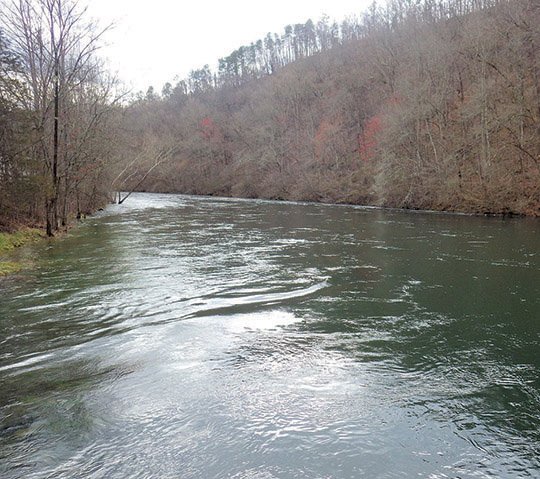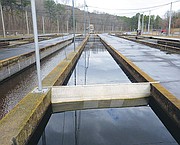Outdoor writer and photographer Corbet Deary is featured regularly in The Sentinel-Record. Today, Deary writes about Greers Ferry National Fish Hatchery.
Arkansas sports its fair share of reservoirs, many of which provide outdoor enthusiasts with an array of opportunities. Our area lakes are all reputable fisheries and beckon anglers galore to try their hand at one of America's greatest pastimes.
There was a time, however, when all of the rivers cutting their way through the state were untamed. But with time came the construction of dams.
The purpose of the huge structures was severalfold. Hydroelectric development was a significant purpose for the dams here in our neck of the woods. In fact, the Remmel Dam, which forms Lake Catherine, was the first hydroelectric power facility in Arkansas and was completed in 1924.
Carpenter Dam, which contains Lake Hamilton, was completed in 1931. The construction of Lake Ouachita followed, with the dedication of Blakely Mountain Dam taking place on July 4, 1956. This was certainly the largest project of the three. The dam was composed of approximately 4 million yards of dirt, containing a reservoir within the neighborhood of 1,000 miles of shoreline and 62 square miles of surface area.
Although the aforementioned reservoirs all produce hydroelectric power, they are also used as a means of flood control. In fact, Lake Ouachita is also used as a water source for portions of Garland and Saline counties.
With the construction of dams throughout the state came a great deal of change. Acres upon acres of land would be consumed of water. But the environment just below these reservoirs would experience a drastic change, as well.
The waters discharging through these structures would be noticeably cooler than the rivers feeding them. In fact, they would be downright cold. And although the water temperature would eventually return to normal farther downstream, the tailwaters of these dams would produce a habitat totally different from the remainder of the rivers.
In fact, these small stretches of waters are conducive to a species of fish that are otherwise not capable of surviving in the waterways cutting their way through the Ouachitas. That's right, I'm talking about trout.
In turn, rainbows are released immediately below our local dams by the hundreds of thousands on an annual basis. And although the reservoirs contained above the dams are still the most popular, their tailwaters beckon many with a passion for trout fishing.
So where do these trout come from? Well, it all begins in a national brood stock hatchery in Tennessee. Although the fertile eggs are produced in a neighboring state, they are transported to the Greers Ferry National Fish Hatchery, near Heber Springs, where they are incubated, reared and eventually released to waters in Arkansas and eastern Oklahoma. The hatchery distributes about 200,000 pounds of trout each year.
Located on the banks of the Little Red River, just below the Greers Ferry Dam, the facility has no shortage of cool water. Coming from the lake, at a depth of 100 feet, the water supply is cold year-round, ranging between 45 and 58 degrees.
Water enters the hatchery and passes through the aeration system at an average of 11,000 gallons per minute.
Eggs are received at the facility and incubated from August through March. The fry, (newborns) are fed commercial fish food five or six times daily. They are extremely vulnerable at this stage and in turn are housed in the juvenile fish rearing area, where only staff members are permitted.
The young trout remain in the fish rearing area until reaching 3 inches in length, which takes four to five months. The fingerlings are then transferred to the outside raceways.
Although they have been in a restricted area throughout the early portion of their life, the young trout are finally in an area where they can be seen and appreciated by the general public. The facility welcomes folks to stop by and check out their operations, In fact, they are open for free, self-guided tours from 7 a.m. till 3 p.m. each day except for Thanksgiving and the federal Christmas holiday.
We stopped by and checked out the hatchery during a recent visit to the Heber Springs area. And to say the tour was less than enjoyable and educational would prove an understatement. The hatchery is a great destination for those who enjoy the sport of fishing. In fact, I would suspect anybody with an inkling of interest in science or the outdoors will find the tour well worth a visit.
We began our excursion with a short tour through the visitor center. And after learning the history and objectives of the hatchery, we embarked upon a short walk to the area where the trout are housed.
There were several raceways containing trout. Although the facility does not raise brood stock, they do have a number of huge rainbows swimming within the perimeters of one of the long and shallow raceways.
I spent a great deal of time watching these trophy-class rainbows swimming to and fro. Although not an avid trout angler, I still found myself dreaming of tying into a rainbow of such proportion. And to imagine trout, every bit as large as those I was admiring, were swimming within the banks of some of our Ozark rivers was more than enough to convince m that I should embark upon a trout fishing excursion in the near future.
The fish swimming in the other vats was not remotely as impressive as the adults. They were, however, intriguing. It was interesting to know that a portion of them might eventually be released in the tailwaters of our local lakes.
There were several vats on the promises and the trout appeared to be contained by size. According to information posted by the hatchery, they would remain at the facility until reaching an 11-inch stocking size. It would take in the neighborhood of 20 months from the time they were hatched till they were ready to be released.
From the hatchery, we embarked upon a short drive through the adjacent camping area to the banks of the Little Red River. Although trout are capable of reproducing in this particular waterway, 180,000 are stocked in the river on an annual basis.
In turn, a number of anglers were casting in its waters during our visit. In fact, trout anglers could be found trying their hand at coaxing these beautiful species from the frigid river several miles downstream.
Although trout are not atop the list of fish species I pursue, that's no indication I failed to enjoy my visit to the Greers Ferry National Fish Hatchery. In fact, I'm eager to stop by the facility again during my next excursion to the Heber Springs vicinity.
To get to the Greers Ferry National Fish Hatchery from Hot Springs: take Highway 70 east 19 miles and take Interstate 30 east. Remain on I-30 for 31.8 miles and take a right onto Interstate 40. Take I-40 for one mile and turn left onto U.S. 67/167. Remain on 67/167 for 16 miles and take (Cabot) Exit 16B. Travel north on Highway 5 for about 53 miles. Turn right onto Hatchery Road shortly after crossing the Greers Ferry Dam and travel a mile to the destination.
Local on 04/18/2018

